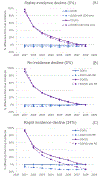Assessing the reliability of the CD4 depletion model in the presence of Ending the HIV Epidemic initiatives
- PMID: 37260256
- PMCID: PMC10524824
- DOI: 10.1097/QAD.0000000000003614
Assessing the reliability of the CD4 depletion model in the presence of Ending the HIV Epidemic initiatives
Abstract
Background: Accurate estimates of HIV incidence are necessary to monitor progress towards Ending the HIV Epidemic (EHE) initiative targets (90% decline by 2030). U.S. incidence estimates are derived from a CD4 depletion model (CD4 model). We performed simulation-based analyses to investigate the ability of this model to estimate HIV incidence when implementing EHE interventions that have the potential to shorten the duration between HIV infection and diagnosis (diagnosis delay).
Methods: Our simulation study evaluates the impact of three parameters on the accuracy of incidence estimates derived from the CD4 model: rate of HIV incidence decline, length of diagnosis delay, and sensitivity of using CD4 + cell counts to identify new infections (recency error). We model HIV incidence and diagnoses after the implementation of a theoretical prevention intervention and compare HIV incidence estimates derived from the CD4 model to simulated incidence.
Results: Theoretical interventions that shortened the diagnosis delay (10-50%) result in overestimation of HIV incidence by the CD4 model (10-92%) in the first year and by more than 10% for the first 6 years after implementation of the intervention. Changes in the rate of HIV incidence decline and the presence of recency error had minimal impact on the accuracy of incidence estimates derived from the CD4 model.
Conclusion: In the setting of EHE interventions to identify persons with HIV earlier during infection, the CD4 model overestimates HIV incidence. Alternative methods to estimate incidence based on objective measures of incidence are needed to assess and monitor EHE interventions.
Copyright © 2023 Wolters Kluwer Health, Inc. All rights reserved.
Conflict of interest statement
SJL reported research grant funding from Gilead Sciences paid to institution and for provision of antiretroviral therapy without cost to study participants. SRM reported research grant funding from Gilead Sciences paid to institution for unrelated research. MET, RG, and CMA report no competing interests.
Figures



References
-
- Fauci AS, Redfield RR, Sigounas G, Weahkee MD, Giroir BP. Ending the HIV epidemic: a plan for the United States. Jama 2019; 321:844–845. - PubMed
-
- Local EHE Plans | Ending the HIV Epidemic | CDC. 2021.https://www.cdc.gov/endhiv/action/local-ehe-plans.html (accessed 28 Apr2022).
-
- Ending the HIV Epidemic Summary - San Diego County. 2021; :4.
-
- Centers for Disease Control and Prevention. Estimated HIV Incidence and Prevalence in the United States, 2015–2019. HIV Surveill Suppl Rep 2021; 26:81.
Publication types
MeSH terms
Grants and funding
LinkOut - more resources
Full Text Sources
Medical
Research Materials

